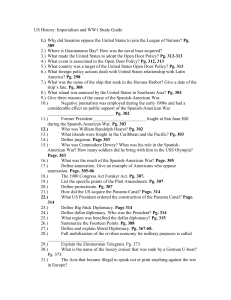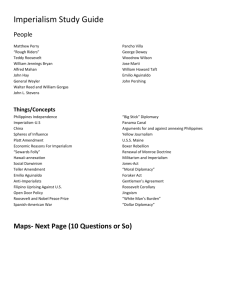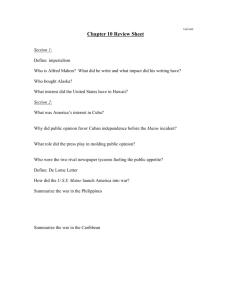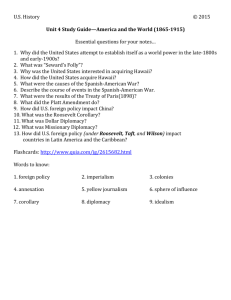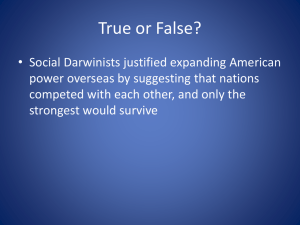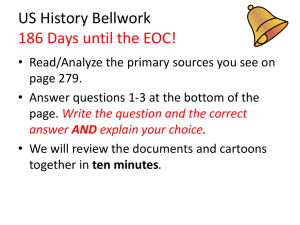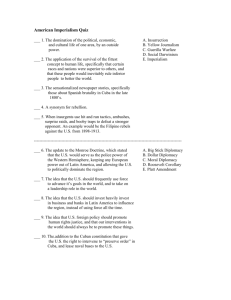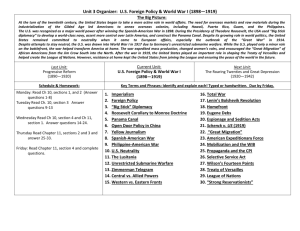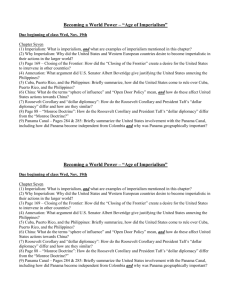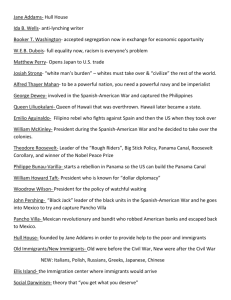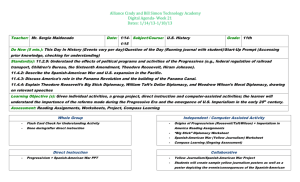Unit III Test (Chp 10) - Coshocton City Schools
advertisement
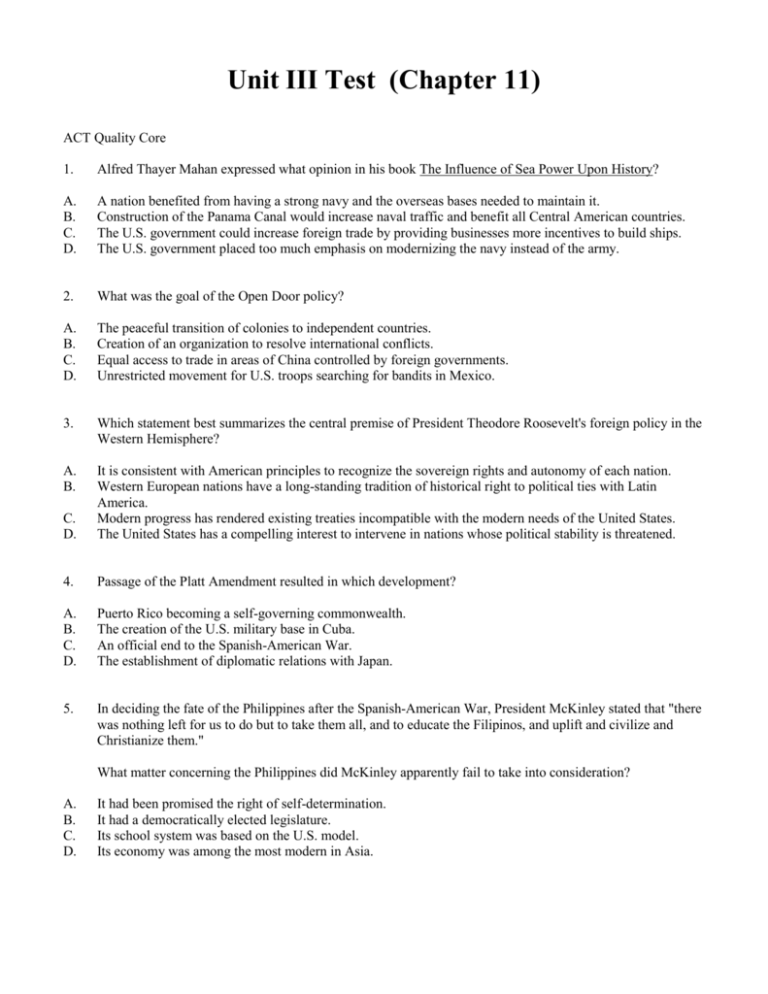
Unit III Test (Chapter 11) ACT Quality Core 1. Alfred Thayer Mahan expressed what opinion in his book The Influence of Sea Power Upon History? A. B. C. D. A nation benefited from having a strong navy and the overseas bases needed to maintain it. Construction of the Panama Canal would increase naval traffic and benefit all Central American countries. The U.S. government could increase foreign trade by providing businesses more incentives to build ships. The U.S. government placed too much emphasis on modernizing the navy instead of the army. 2. What was the goal of the Open Door policy? A. B. C. D. The peaceful transition of colonies to independent countries. Creation of an organization to resolve international conflicts. Equal access to trade in areas of China controlled by foreign governments. Unrestricted movement for U.S. troops searching for bandits in Mexico. 3. Which statement best summarizes the central premise of President Theodore Roosevelt's foreign policy in the Western Hemisphere? A. B. C. D. It is consistent with American principles to recognize the sovereign rights and autonomy of each nation. Western European nations have a long-standing tradition of historical right to political ties with Latin America. Modern progress has rendered existing treaties incompatible with the modern needs of the United States. The United States has a compelling interest to intervene in nations whose political stability is threatened. 4. Passage of the Platt Amendment resulted in which development? A. B. C. D. Puerto Rico becoming a self-governing commonwealth. The creation of the U.S. military base in Cuba. An official end to the Spanish-American War. The establishment of diplomatic relations with Japan. 5. In deciding the fate of the Philippines after the Spanish-American War, President McKinley stated that "there was nothing left for us to do but to take them all, and to educate the Filipinos, and uplift and civilize and Christianize them." What matter concerning the Philippines did McKinley apparently fail to take into consideration? A. B. C. D. It had been promised the right of self-determination. It had a democratically elected legislature. Its school system was based on the U.S. model. Its economy was among the most modern in Asia. 6. Why did President Theodore Roosevelt involve the United States in the Dominican Republic's affairs when that country defaulted on its debt payments? A. B. The Dominican Republic had supported the United States during the Spanish-American War. Under the Monroe Doctrine, the United States aimed to prevent the possible intervention of European nations. Revolutionaries were poised to take power if the Dominican Republic's democratically elected government collapsed. Instability in the region could have impeded the course of Manifest Destiny C. D. 7. What is the correct chronology of the foreign policy initiatives of Presidents McKinley, Theodore Roosevelt, Taft and Wilson? A. B. C. D. Big Stick Diplomacy, Dollar Diplomacy, Open Door Policy, Moral Diplomacy. Dollar Diplomacy, Big Stick Diplomacy, Moral Diplomacy, Open Door Policy. Open Door Policy, Big Stick Diplomacy, Dollar Diplomacy, Moral Diplomacy. Moral Diplomacy, Open Door Policy, Big Stick Diplomacy, Dollar Diplomacy. 8. Why did a split occur among feminists in the late nineteenth century? A. Many feminists believed the increasing economic independence of educated women after the Civil War indicated there was no need for further activism. Many feminists left the United States to settle in countries with more progressive attitudes toward women. Feminists disagree on the suffrage movement's goals and tactics after women's suffrage was not included in the Fifteenth Amendment. Feminists argued over which political party was most likely to help the suffrage movement. B. C. D. 9. Largely characterized by resentment of European influence over the Chinese government, the Boxer Rebellion resulted in attacks on foreign-owned properties. Why did U.S. interests in China also come under attack during this time? A. B. D. The United States offered no assistance to China during the 1895 war with Japan. The Open Door policy attempted to secure for the United States the same power enjoyed by other Western countries in China. China's ability to conduct unrestricted trade with the Philippines was jeopardized by the U.S. victory in the Spanish-American War. U.S. policies that unfairly restricted Chinese immigration created political tensions between the countries. 10. Which event most influenced development of the Roosevelt Corollary? A. B. The passage of the New Deal. The journey of the Great White Fleet. C. C. D. The annexation of Hawaii. The implementation of the Platt Amendment. 11. During the Progressive era, disagreement over which tactic created the most significant split among female suffragists. A. B. C. D. Whether men should play a leading role in helping women achieve the right to vote. Whether the use of economic boycotts would force the government into granting women the right to vote. Whether the use of violence would diminish public support for women's right to vote. Whether women seeking the right to vote should concentrate on the national or state level. 12. What issue does this political cartoon from the 1890's depict? A. B. The revolution in Panama. The plight of Cuba. 13. What was the main goal of the Open Door policy toward China? A. B. C. D. To encourage increased emigration from China to the United States. To stimulate democratic reform in China. To encourage China to allow U.S. business activity. To develop friendly diplomatic relations with China. 14. As the twentieth century dawned, the emergence of powerful European spheres of influence in Southeast Asia shaped the development of what U.S. foreign policy? A. B. Dollar Diplomacy Roosevelt Corollary C. D. C. D. The annexation of Hawaii. The dictatorship in Costa Rica Open Door Manifest Destiny 15. Which development prompted formulation of the Roosevelt Corollary to the Monroe Doctrine? A. B. C. D. Spain's reluctance to sign a peace treaty after the Spanish-American War. Latin America countries defaulting on their debts to foreign investors. Rebels threatening to overthrow Mexico's democratic government. Attacks on U.S. workers during construction of the Panama Canal. 16. Which desired outcome most influenced President McKinley's decision to maintain U.S. control of the Philippines after the Spanish-American War? A. B. C. D. Increased commercial opportunities for U.S. businesses. Assured safety of U.S. religions missionaries. Reduced flow of immigration from Asia. Extended reach of the Monroe Doctrine. 17. Which of the following did the American Anti-imperialist League oppose? A. B. C. D. U.S. conquest and possession of overseas territories. Extension of the right to vote to women. Government regulation of large businesses. Federal legislation ensuring food safety. 18. The Spanish-American War is most directly associated with which event? A. B. The Philippine Insurrection. The Boxer Rebellion. 19. Which situation prompted the U.S. government to actively encouraged a 1903 revolt in Central America? A. B. C. D. Columbia refused to ratify an agreement allowing construction of the Panama Canal. Socialist politicians were threatening to nationalize U.S. owned businesses. France was reluctant to give up its colonial possessions in the Western Hemisphere. The U.S. military needed to secure territorial possessions gained after the Spanish-American War. 20. What cause was the primary focus of Susan B. Anthony's activism? A. B. Immigration Labor 21. Which lands did the United States acquire as a result of the Spanish-American War? A. B. Alaska and Hawaii Guam, the Philippines and Puerto Rico C. D. C. D. The establishment of the Roosevelt Corollary. The annexation of the Hawaiian Islands. Public education Women's suffrage C. D. Louisiana Territory and the Old Northwest Texas and New Mexico 22. What was the goal of President Taft's Dollar Diplomacy? A. B. C. D. To help U.S. allies increase the readiness of their armed forces. To raise the living standards of people in poverty-stricken countries. To support the development of democracies in Central America. To create stability abroad for the benefit of U.S. commercial interests. 23. What prompted the U.S. government to participate in the 1893 overthrow of the Hawaiian government? A. B. C. D. The colonization of Pacific islands near Hawaii by European nations. The kidnapping of Christian missionaries by Hawaiian nationalists. Queen Liliuokalani's attempt to reduce the political influence of American sugar planters. King Kalakaua's discussions with the Japanese government to lease Pearl Harbor. 24. Which development motivated President Theodore Roosevelt to send the Great White Fleet on a fourteen month worldwide tour? A. B. C. D. Increased political tensions in territories acquired by the United States during the Spanish-American War. Reluctance on the part of the European powers to accept the United States Open Door policy. Pirates seizing United States ships off the coast of Africa and holding them for ransom. Japan's emergence as a world power after its defeat of Russia in a 1905 war. 25. President Theodore Roosevelt considered the voyage of the Great White Fleet essential to accomplishing which of the foreign policy goal? A. B. C. D. Establishment of overseas coaling stations for the U.S. Navy. Repair of United States' international reputation following the Philippine insurrection. Demonstration of United States' ability to defend its international interests. Increase military spending for the purpose of establishing U.S. supremacy. 26. What early twentieth-century foreign policy development is associated with the region depicted on this map? A. B. Alliance for Progress Big Stick C. D. Domino theory Open Door OGT '09 27. (30) During the Spanish-American War, the U.S. Navy destroyed the Spanish fleet in Manila Bay in the Philippines. The U.S. Congress later voted for annexation of the Philippines. What was one reason for this act of Imperialism? A. B. C. D. To decrease the U.S. need to export raw materials for industrialization. To provide the U.S. with a place to relocate its immigrant population. To provide the U.S. with a valuable naval base in the Pacific. To increase the U.S. population by extending citizenship to the Filipinos. OGT '08 28. (34) During the late 19th and early 20th centuries, U.S. foreign policy was closely tied to domestic economic concerns. The annexation of Hawaii, the Open Door Policy with China and the construction of the Panama Canal in Latin America were all motivated by an interest in: A. B. C. D. Acquiring new markets and sources of raw materials. Extending land grants for railroad construction. Breaking up monopolies and trusts. Limiting the power of labor unions to strike. 29. (36) The famous American writer Mark Twain expressed his opinion about U.S. actions in the Philippines after the Spanish-American War with the following words: "I have seen that we do not intend to free, but to subjugate (place under control) the people of the Philippines. We have gone to conquer not to redeem (save) . . . I am opposed to having the [American] eagle put its talons on any other land." The New York Herald, October 15, 1900. This statement would be helpful in supporting the thesis that Mark Twain believed that: A. B. C. D. U.S. imperialism civilized the people of the Philippines. U.S. imperialism would bring stable government to the Philippines. U.S. imperialism was necessary for the United States to become a world power. U.S. imperialism was wrong. OGT '06 30. (9) In 1898, U.S. support for Cuban independence led to war with Spain and contributed to the United States becoming an imperial power. What was a decisive factor in the decision to go to war? A. B. C. D. The opportunity to annex Hawaii. The desire to acquire a naval base. The protection of U.S. commerce and trade. The need for a shorter route from the Atlantic to the Pacific. OGT '05 31. (38) One factor that motivated U.S. imperialism during the late 19th and early 20th centuries was the: A. B. C. D. Development of closer political ties with European nations. Acquisition of new markets and sources of raw materials. Support of international peacekeeping operations. Closing of China to all foreign trade. OGT '04 Practice Test 32. (23) One objective of 19th-century European imperialism was to: A. B. C. D. Preserve native cultures and traditions. Expand peace and freedom. Protect the environment and conserve wildlife. Convert inhabitants of foreign territories to Christianity. OGT '09 33. (39) Essay (2 pts) The United States fulfilled one of its imperialist ambitions in the early 20th century by acquiring land to build the Panama Canal. State two reasons (political and/or economic) why U.S. imperialists wanted to build the canal. ACT Quality Core 34. (Essay) This cartoon was published in the Philadelphia Press in 1898, during what is commonly referred to as the "Age of Imperialism" in U.S. history. Examine the cartoon carefully; then complete the following tasks. * Explain the meaning of the caption "Ten thousand miles from tip to tip." * Explain the artists views on imperialism by discussing at lease TWO different uses of symbolism in the cartoon. Then support your interpretation by describing the history of U.S. imperialism involving two of the islands shown on the map.
